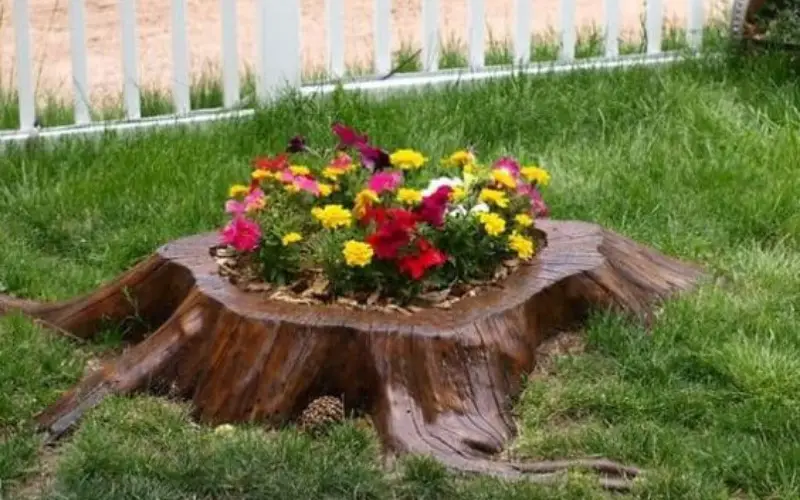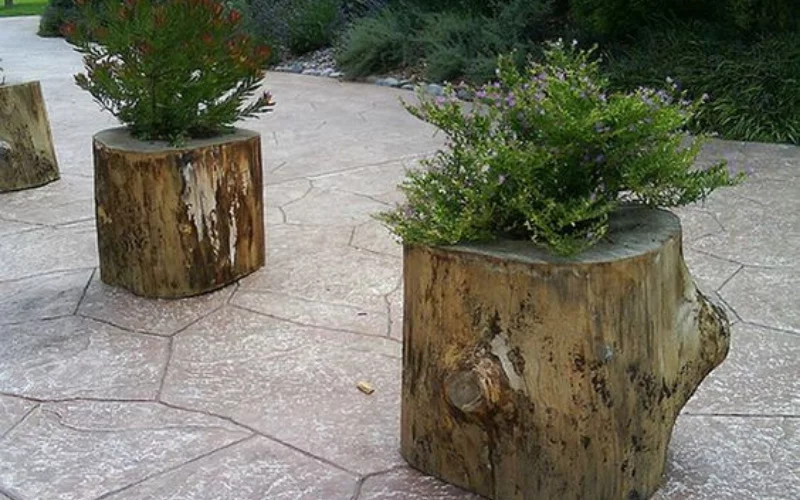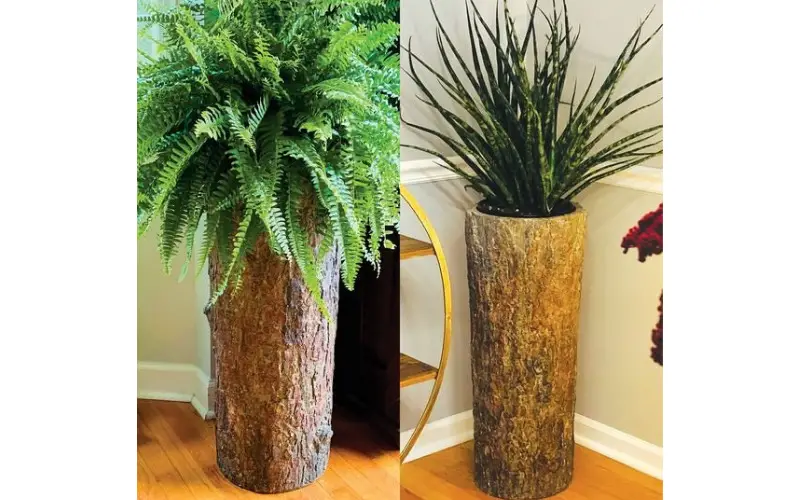Many people perceive a tree stump as an unsightly nuisance in their backyard. In contrast, for some others, a tree stump offers a beautification opportunity to their garden that may be said to be delightfully rustic.
Once a tree is cut and fell, what is left in the ground is the stump that you either try to kill, rot, and decompose or, you can turn them into eccentric furniture that can be used both for outdoor and indoor purposes. The option you go with depends on your perception and personality.
Tree stumps which were once seen as eyesores that people try so desperately to remove are now being put into different uses that are amazing.
Do you know the feeling you get when you eat out of a plate made from a tree stump or sit in a chair that was once a tree stump? It gives a feeling that is better experienced.
Today, we will tell you all the amazing things you can do with your tree stump. But first, you must know how to preserve these tree stumps before attempting any one of them.
Why Keep a Tree Stump?
When you convert your old or discarded objects or materials into something beautiful and valuable, then we say that you are UPCYCLING.
You can decide to upcycle your tree stump by converting them into new utilities that you can use for indoor and outdoor activities.
The outdoor use you can put your tree stump include but are not limited to.
- Mosaic decoration in your backyard: you can turn that annoying tree stump in your backyard into a piece of art by doing some mosaic designs on them where they stand. They can become the focus of your garden, the object of discussion and attention when family and friends come visiting, hence making it a thing of pride.
- Flower planters: this is a beautiful way of upcycling your tree stump. You can plant flowers and other ornamental plants on a tree stump to get people interested in your creation. All you need do is to chisel out some of the wood from the tree stump center and then pour in soil and plant your flower inside the tree stump.
- Sculpture: you can get a Sculptor to create a beautiful sculpture out of the stump in your backyard. You can make exciting figures like your pets, animals, and other things out of the wood of the tree stump.
- Miniature playhouse: many people have creatively turned their tree stump into different playsets for children, from miniature tree houses to the part of a slide in the garden.
- Footpath: do you know how amazing sight is when people put slices of their tree stump, which they color and decorate and then turn them into steps they put on their footpath for people to step on. It is indeed amazing.
There are many other things you can turn your tree stump into that can equally look beautiful.
Indoor Uses of Tree Stumps
You can do so many things with a tree stump indoors that it is impressive we are discovering it now. Some of the uses you can put your tree stump for indoor purposes include:
- Plates: you can cut slices of your tree stump, treat them, and use them as plates for eating.
- Candleholder: you can also use the tree trunks from your tree stump and use them as candle holders.
- Tables, stools, and chairs: you can convert your tree stump into furniture that you can use both indoors and outdoors.
You can put your tree stump to other uses, including a wall clock, a chopping board, amongst others.
How Long Will a Tree Stump Last?
The tree stump left on its own can last for seven to ten years, even though it can last longer depending on so many things.
Remember the roots of trees go so deep into the ground, and if left alone, their roots can remain intact once it keeps getting nutrients and other things it needs.
Below are some of the factors that will affect how long a tree stump will last:
- The tree species: some species of a tree stump can live longer than others.
For instance, harder wood stumps will live longer than softer wood stumps.
- The health of the tree before it was cut down: trees that are healthy before they were cut down stand a better chance of lasting longer than the diseased one, and so too it is with their stumps.
- The environment: if the soil environment in which the tree stump is growing is healthy and full of nutrients with fewer pathogens, the chances are that the tree stump will last longer.
- Proximity to other trees: science made a startling discovery showing that the roots of trees planted in the same place can share their nutrients from underground. So, if your tree stump is close to other trees, then it is expected to last longer than others who are solitary.
How Do You Keep a Tree Stump from Rotting?

All trees stump, no matter how good they look or healthy they are. They will decompose and eventually turn into a fine-saw dust-like material.
Fungi are the main decomposes of tree stumps and keep them from rooting, then deal with the fungi that attack them. You can follow the steps below to keep your tree stupid from rotting:
- Clean the surface of your tree stump with a washcloth and warm water. Make sure that all dirt and debris are cleared entirely from the stump surfaces. Remove the bark of the tree stump too to expose the wood of the tree stump.
- Use sandpaper to smoothen the surface of the stump. Start firstly with high-grade sandpaper and afterward use a fine-grit paper to smoothen out the entire tree stump
- Use a damp washcloth to clear off all the debris from the sanding of the stump.
- Apply two or three coats of wood sealant on the stump and leave it like that for two days. This will ensure that any insects or fungi that cannot attack the wood will deteriorate the tree stump.
We can now say that your tree stump is now preserved.
Many people use fungicides to kill the fungi in tree stumps that cause them to rot. These chemicals are also effective, but you have to be conscious that they remain active for about six months once applied to the tree stump.
If you have kids and pets around the house who go out to play, the chances are that they might touch the stump surface, which might irritate their hands and can pose a chemical hazard to them.
Secondly, they are not as eco-friendly as using the first option. Remember, the world is going green, and we want to minimize pollution to our environment in any way that we can.
How Do You Preserve a Tree Trunk with Bark?
The rustic appeal of a tree stump can be made more appealing if the bark of the tree stump is still left on the stump. You can preserve your tree stump with its bark by doing the following:
- Cut the tree trunk from the stump at the dormant period when it is not possible for the bark to pull off from the trunk. Your best options are pines and oak trees whose bark hardly peel off naturally.
- Get a plastic or a fiberglass container that can take the size of the tree trunk. Then lay adequate numbers of wood skewers so that the tree trunk does not directly lay on the container’s bottom. Gently place the wood inside the container.
- Pour wood preservatives or stabilizers like pentacryl to prevent wood splitting or crack into the container. The recommended quantity is 240ml of pentadactyl will go for every 30cm of wood. If the tree is too big that it cannot fit into the container, then dip one end of the trunks into the solution in the container and leave it for 4 days and afterward, pit the other end of the trunk and leave for another 4 days you can even brush the wood with the pentacryl solution if the trunk is too big to be fitted in a container.
- The container should be covered and a plastic wrap to prevent the stabilizer from evaporating. If the container does not have a cover, then improvise with a trash bag. For the trunk that can fit into the container, wrap the trash bag found in the trunk.
- Leave the wood in this solution for about 24-36 hours, depending on the trunk’s thickness. The thicker the trunk, the more time for the trunk to be left soaking on the solution.
- Remove the trunk from the container and keep it in a wire rack to drain. You can wrap bigger trunks with plain paper.
- Place the tree trunk vertically in a box and loosely cover the box so that air can enter. Keep in a place whose temperature is not less than 10°, and for not allow the trunk to receive direct heat from the sun or the wood will split from drying rapidly.
- Keep this trunk like this until it is completely dry. This can take from 3 weeks to a few months, depending on the size, wood, and thickness of the trunk.
- You can sand the trunk to get it to be very smooth, and you can also stain it if you want the wood to be tinted.
- Dip your brush into polyurethane and then spread over the trunk and the bark and let it dry for 24 hours.
After that, your tree stump with its bark is preserved.
How Do You Preserve a Tree Stump for Outdoor Use?

If you keep your tree trunk for use outdoors as garden paths, mosaics, or even outdoor tables, you can follow the steps below to preserve your tree stump.
- Clean the surface of your tree stump with water and a clean washcloth.
- Stabilize the tree stump by applying pentcryl, which will keep it from cracking.
- Seal the tree stump with a Wood sealer like Agra life lumber guard, Thompson water rain guard, or any other sealer for that matter. You need to do this because your stump will be used outside and exposed to the elements and so must be protected.
- Lay the tree stump to dry put. If you can control the drying process so that it doesn’t dry too quickly, the better it could cause the wood to crack.
With the stump thoroughly dried, you have it completely preserved for outdoor uses.
How Do You Preserve Tree Stump for Indoor Uses?

The method used to preserve a tree stump with its bark is the same one used to preserve a tree for indoor uses. The only difference is that after you have cleaned the stump, put it in a container that has pentcryl solution; you allow it to soak in that solution for a couple of days, then when you remove them and dry them, you should place them vertically in a box that is loosely close for it to continue drying.
Remove the tree stump from the box after 4 weeks, and then treat it with preservatives that can make it fit for use, even as plates for eating.
How Do You Preserve a Tree Trunk Slices?
To preserve your tree stump slices for both indoor and outdoor uses, do the following:
- Get a professional to cut slices from your tree stump. You can use a chain saw to cut the slices you feel up to it. But the best thing to do is to get someone who is trained to cut this slice safely and neatly
- Use a washrag and water to clean these wood slices thoroughly to remove any dirt or debris that might remain from the slicing of the tree stump.
- Smoothen the surfaces of your tree stump using sandpaper. The smoother the tree stump slices you have, the more appealing they will look.
- Apply coats of pentacry to them and allow them to sit for 48 to 36 hours. This will keep your treatment stump slices looking good for long.
Can You Preserve a Tree Stump On The Ground?
Yes, indeed you can; all you need to do is follow the same procedure for preserving tree stump for outdoor uses and preserve your tree stump around.
Many people are coming up with ideas that turn tree stumps left on the ground into a piece of art and a thing of beauty. So yes, you can leave your tree stump and use it right where it is.
What Can I Plant Over a Tree Stump?
The art of using a tree stump as a flower planter is gaining prominence because of how amazing they look. You can plant different flowers and ornamental plants in your tree stump.
But whatever your choice of plant, ensure that you plant only shallow-rooted plants because the tree stump would not have enough room for any other type of plant.
There is a wide range of plants that fit into the description above, from which you can choose based on your preference and style. Some common crops that are planted on tree stumps include:
- Ferns of different species.
- A wide range of wild shrubs,
- Marigold, phox, cornflowers anon others.
Conclusion
That tree stump in your backyard does not need to be left rotting and constituting a nuisance to you and your family by being the insects and fungi that habit them. You can preserve these stumps from dying and rotting and even reserve them for something useful.
The list of things you can use these tree stumps to do for indoor and outdoor purposes is enormous. So, when next you see that unsightly tree stump in your backyard, see it foe r what it is: a piece of beauty that is waiting to be worked on.
You May Also Like:
- How to Get Rid of a Tree Stump With Charcoal
- How To Anchor a Swing Set on Grass, Turf, And Concrete?
- How to Keep Inflatable Pool Water Clean With Salt
- How Long Can You Leave Water in an Inflatable Pool
- How Do You Rot a Tree Stump Naturally?
We trust this article helped you learn How to Preserve a Tree Stump. You may also want to bookmark our report on Easy Way to Remove a Tree Stump.
Thanks for taking the time to read our article, and we hope you find it helpful. Would you mind leaving a comment below if you have any suggestions?
Kindly reach out to people by sharing this post on social media.
If you liked this article, then please follow us on Facebook, Instagram, and Pinterest.
